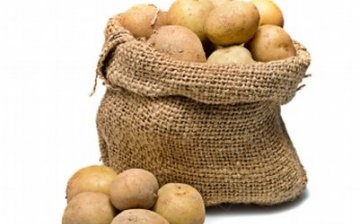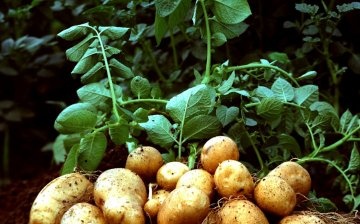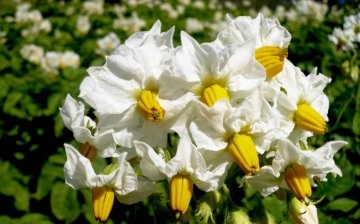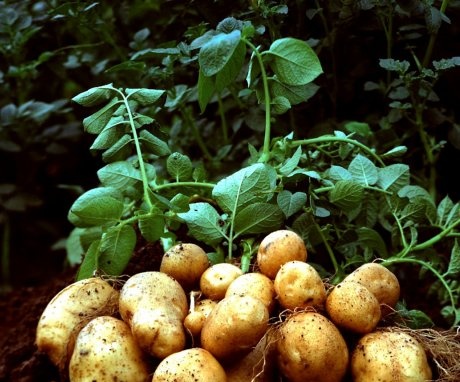The structure of the potato tuber, as well as the reproduction and care of the popular vegetable
The potato has been known for many years. And for many, this product has become a favorite. This plant is unpretentious in care. This plant can be found in the country house of almost every amateur gardener.
Retention:
- Characteristics of potato tuber
- Description of potatoes of different varieties
- Potato care
- Potato propagation
Characteristics of potato tuber
The potato is a herbaceous bush that belongs to the nightshade family. The branches of the bush can be spreading or erect, it all depends on the variety. Leaves and potato tubers... In the upper part of the branches there are peduncles with small buds. The fruits of potatoes are small round berries, up to 2 cm in diameter.
Leaves are not used for food, since they have toxic substances in their composition. The structure of the potato tuber is approximately the same for all varieties. The growing season, the color of the pulp, the shape and color of the skin differ.
The tuber is formed on the underground part of the stem.
Depressions are formed on each, where there are 2-3 kidneys, they are also called eyes.
Description of potatoes of different varieties
Potato varieties are divided into five types: early, mid-early, mid-season, mid-late and late. For every kind there are many varieties... Many of them are suitable for cold regions, others for warm ones.
Early potato varieties:
- Antonina. Ripening takes place within 2 months after the first shoots appear. The bush of this variety is tall with erect stems. The leaves are large, located mainly on the tops of the branches. The tubers are large, oblong. The peel is rough, colored in a yellow-sandy tone. The pulp is starchy, yellowish.
- Vega. This variety has a short ripening period of only 55 days. The height of the bush is average. Erect branches are densely packed with dark green leaves. The tubers are sandy in color, their flesh is dark yellow. The variety is resistant to common diseases.
- Vineta. An early variety, ripens 50 days after germination. Medium-sized bush with branchy branches. The leaves are colored light green. Oblong, oval, wavy. Medium sized tubers with yellow skin and light creamy starchy flesh. The variety tolerates drought well.
- Strong guy. Tall shrub with erect stems. Yields a harvest within 55 days after germination. Leaves are medium in size, oblong, colored green. Tubers are medium in size, elongated, with a yellow skin and white flesh.
Medium early potato varieties:
- Visa. Ripens in 75 days after germination. The bush of this variety is small, leaves are medium in size. The tubers are large, rounded, oblong with a smooth, red-colored skin. The pulp is creamy. The variety is resistant to disease.
- Nevsky. Maturation occurs in 80 days. The variety is popular and has a high yield. Stems are straight, branched, low. Small leaves are colored green. Tubers are medium to large in size, oval, white-yellow skin. The pulp is light, starchy.
Mid-season potato varieties:
- Giant. Ripening occurs 3 months after germination. The bush is tall, with erect stems and large leaves. The tubers are large, oval.The skin is smooth and sandy in color. The pulp is creamy and has a high starch content.
- Bulletin. Ripens in 85 days. The bush is tall, the stems are straight and thick. The leaves are large, painted green, not densely located on the upper part of the branches. This variety blooms profusely with reddish purple petals. The tubers are large, oval. The peel is rough, colored in a sandy tone. The pulp is light and contains a large amount of starch.
- Prestige. Ripening period - 3 months. The height of the bush is average, the branches are large, slightly spreading. Leaves are oval, large, green. The tubers are oval, the skin is smooth, dark sandy in color. The pulp is yellow, starchy.
Medium late potato varieties:
- Arsenal. A bush with tall branches that can be erect or semi-spreading. The leaves are large, oblong-oval, colored in a green tone. The tubers are large, oblong. The skin is yellowish, the flesh is light.
- Bafana. This variety ripens 4 months after the first shoots appear. The bush is tall, the stems are slightly spreading. The leaves are large. The tubers are oval, their skin is yellow. The pulp is light with a high starch content. The variety is resistant to many diseases.
- Veteran. Medium-sized bush. The branches are erect and semi-spreading. Leaves are medium in size. Tubers are medium in size, oval, oblong. The skin is yellow, smooth. The pulp is light.
Late potato varieties:
- Atlant. Ripens 4 months after germination. The bush is medium in size, the branches are slightly spreading. It does not bloom thickly, the buds are painted in a white tone. The tubers are large, the peel is thick, colored yellow. The pulp is light beige, starchy.
- Vesnyanka. Ripens in 4 months. The shrub is medium in size. It blooms profusely and densely, the buds are located on peduncles, the petals are painted in a lilac-red tone. The tubers are very large and round. The peel is dense, yellow. The pulp is pinkish.
- Manitou. This variety belongs to the Dutch. The bush is large with erect stems. The leaves are very large, dark green in color. It blooms profusely, the buds are painted in a reddish-purple tone. The tubers are large, rounded with a reddish-pink skin. Yellow pulp contains a lot of starch.
Potato care
Watering potatoes is necessary in the pre-emergence period and during active growth. However, do not overmoisten the soil, this can lead to rotting of the tubers. Before harvesting, when the tubers are already ripe, the bushes are not watered. In areas where the soil has a high percentage of moisture, potatoes are planted on specially made combs.
It is also necessary to regularly loosen the soil around the bush and remove weeds.
When the branches of the bush have grown by 10-15 cm, the plant is spud, that is, the bush is strengthened by adding earth. The plant does not need additional fertilization and feeding, since all chemicals can accumulate in the tubers. It is recommended to fertilize the soil before planting the potatoes.
Potato propagation
Potatoes are propagated by tubers and seeds. Seeds are formed after flowering on the aerial part of the bush. But mainly tuber reproduction is used. Each potato has a groove with buds from which shoots sprout.
In the spring, these potatoes are planted in 1-2 holes, sprouts up. It is necessary to leave a gap of 35-40 cm between the bushes. 60 cm between the rows.
When planting, it is necessary to choose a variety that is most suitable for the region where it will grow.
Having picked up the wrong variety, many problems with diseases and pests... Potatoes are treated for diseases and pests in the early period. That is, the bushes can be sprayed before the flowers appear. But recently, a lot of biological products have appeared that can be applied during and after the flowering period of the bush. These preparations are natural and their substances do not accumulate in the tubers of the plant.
More information on breeding potatoes can be found in the video.

















We like the Nevsky variety, it grows well in our garden. In addition, the Rodrigo variety has recently begun to be planted. We plant such potatoes for 2 - 3 years, and then we renew the planting material, otherwise the potatoes begin to degenerate.